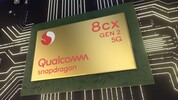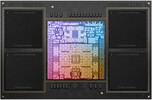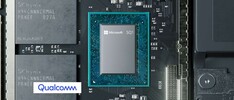Qualcomm Snapdragon 8cx Gen 2 5G vs Apple M2 Max vs Microsoft SQ1
Qualcomm Snapdragon 8cx Gen 2 5G
► remove from comparison
The Qualcomm Snapdragon 8cx Gen 2 5G Compute Platform (or SD8cx Gen2, SC8180XP) is a ARM based SoC for Windows laptops. It integrates a similar CPU part as the Snapdragon 855 (same cores but without the Prime Core feature) and is manufactured in 7nm at Samsung. The 4 Kryo 495 Gold cores are based on the ARM Cortex-A76 architecture (for performance) and clocked at 3.15 GHz under load. The 4 Kryo 495 Silver cores are small ARM Cortex-A55 cores for power efficiency and clocked at 1.8 GHz under load (most likely).
Compared to the predecessor, the Snapdragon 8cx, the Gen 2 offers higher clock speeds and an integrated 5G modem (X55 with Sub-6 GHz and mmWave support). Wi-Fi was also bumped up to Wi-Fi 6
The processor performance should be similar to a Intel Core i5 8th gen U-series (e.g. i5-8250U) according to Qualcomm. However, this is only the case for native ARM64 compiled Windows apps which are not that many (in mid 2019). 32 bit applications and games for AMD/Intel run in a rather slow emulation and 64 bit apps wont start at all (but an emulator should come in Windows in 2021).
The integrated Adreno 680 graphics card could also be a bit higher clocked.
The chip is very power efficient as its produced at TSMC in the modern 7 process. Therefore, laptops using the Snapdragon 8cx can be passively cooled (no fan) and should not throttle under constant load.
Apple M2 Max
► remove from comparison
The Apple M2 Max is a System on a Chip (SoC) from Apple that is found in the early 2023 MacBook Pro 14 and 16-inch models. It offers all 12 CPU cores available in the chip divided in eight performance cores (P-cores) and four power-efficiency cores (E-cores). The E-cores clock with up to 3.4 GHz, the P-Cores up to 3.7 GHz (mostly 3.3 GHz in multi-threaded workloads and 3.4 GHz in single threaded).
The big cores (codename Avalanche) offer 192 KB instruction cache, 128 KB data cache, and 36 MB shared L2 cache (up from 24 MB in the M1 Pro). The four efficiency cores (codename Blizzard) are a lot smaller and offer only 128 KB instruction cache, 64 KB data cache, and 4 MB shared cache. CPU and GPU can both use the 49 MB SLC (System Level Cache).
The unified memory (32, 64, or 96 GB LPDDR5-6400) next to the chip is connected by a 512 Bit memory controller (400 GB/s bandwidth) and can be used by the GPU and CPU.
The CPU performance should be quite similar to the M2 Pro as only the higher memory bandwidth and bigger L3 cache could make a difference for some workloads.
The integrated graphics card in the M1 Max offers a 30-core GPU or a GPU with all 38 cores.
Furthermore, the SoC integrates a fast 16 core neural engine (faster than M1 Max), a secure enclave (e.g., for encryption), a unified memory architecture, Thunderbolt 4 controller, an ISP, and media de- and encoders (including ProRes).
The M2 Max is manufactured in 5 nm at TSMC (second generation) and integrates 40 billion transistors. The power consumption of the CPU part is up to 36 Watt according to powermetrics. When fully loading the CPU and GPU cores, the chip uses up to 89 Watt and the CPU part is limited to 25 Watt.
Microsoft SQ1
► remove from comparison
The Microsoft SQ1 is a ARM based SoC for Windows tablets (Surface Pro X). It is based on the Snapdragon 8cx but with higher clocked CPU and GPU cores. The CPU cores clock with up to 3 GHz. The 4 Kryo 495 Gold cores are based on the ARM Cortex-A76 architecture (for performance) and clocked at up to 3 GHz (2.84 GHz for the 8cx) under load (no single core Turbo). The 4 Kryo 495 Silver cores are small ARM Cortex-A55 cores for power efficiency and clocked at 1.9 GHz (unverified) under load. The integrated X24 LTE modem supports up to 2 Gbps download speeds. Furthermore, the SoC integrates ac-Wifi and a dual-channel 32-bit 1866 MHz LPDDR4x memory controller.
The processor performance should be similar to a Intel Core i5 8th gen U-series (e.g. i5-8250U) according to Qualcomm. However, this is only the case for native ARM64 compiled Windows apps which are not that many (in mid 2019). 32 bit applications and games for AMD/Intel run in a rather slow emulation and 65 bit apps wont start at all.
The integrated Adreno 685 graphics card is a higher clocked version of the Adreno 680 in the Snapdragon 8cx. Microsoft claims 2 TFlops theoretical performance compared to the 1.8 for the Adreno 680 (+11%).
The chip is very power efficient as its produced at TSMC in the modern 7 process. Therefore, laptops using the Snapdragon 8cx can be passively cooled (no fan) and should not throttle under constant load.
| Model | Qualcomm Snapdragon 8cx Gen 2 5G | Apple M2 Max | Microsoft SQ1 | ||||||||||||||||||||||||||||||||||||||||
| Series | Qualcomm Snapdragon | Apple Apple M2 | Qualcomm Snapdragon | ||||||||||||||||||||||||||||||||||||||||
| Codename | Cortex-A76 / A55 (Kryo 495) | Cortex-A76 / A55 (Kryo 495) | |||||||||||||||||||||||||||||||||||||||||
| Series: Snapdragon Cortex-A76 / A55 (Kryo 495) |
|
|
| ||||||||||||||||||||||||||||||||||||||||
| Clock | 3150 MHz | 2424 - 3696 MHz | 3000 MHz | ||||||||||||||||||||||||||||||||||||||||
| L3 Cache | 2 MB | 48 MB | 2 MB | ||||||||||||||||||||||||||||||||||||||||
| Cores / Threads | 8 / 8 | 12 / 12 | 8 / 8 | ||||||||||||||||||||||||||||||||||||||||
| TDP | 7 Watt | 79 Watt | |||||||||||||||||||||||||||||||||||||||||
| Technology | 7 nm | 5 nm | 7 nm | ||||||||||||||||||||||||||||||||||||||||
| Features | X24 LTE Modem, Adreno 680 GPU | ARMv8 Instruction Set | X24 LTE Modem, Adreno 685 GPU | ||||||||||||||||||||||||||||||||||||||||
| iGPU | Qualcomm Adreno 680 | Apple M2 Max 38-Core GPU | Qualcomm Adreno 685 | ||||||||||||||||||||||||||||||||||||||||
| Architecture | ARM | ARM | ARM | ||||||||||||||||||||||||||||||||||||||||
| Announced | |||||||||||||||||||||||||||||||||||||||||||
| Manufacturer | www.qualcomm.com | www.microsoft.com | |||||||||||||||||||||||||||||||||||||||||
| L1 Cache | 3.3 MB | ||||||||||||||||||||||||||||||||||||||||||
| L2 Cache | 36 MB | ||||||||||||||||||||||||||||||||||||||||||
| Transistors | 67000 Million |


 Deutsch
Deutsch English
English Español
Español Français
Français Italiano
Italiano Nederlands
Nederlands Polski
Polski Português
Português Русский
Русский Türkçe
Türkçe Svenska
Svenska Chinese
Chinese Magyar
Magyar
